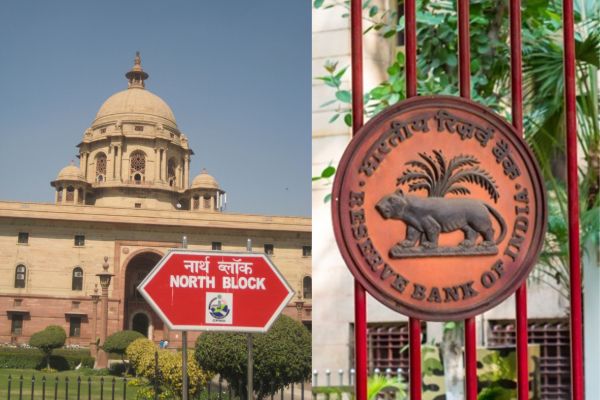.png)

Dhananjay Sinha, CEO and Co-Head of Institutional Equities at Systematix Group, has over 25 years of experience in macroeconomics, strategy, and equity research. A prolific writer, Dhananjay is known for his data-driven views on markets, sectors, and cycles.

Kalyan Ram, a financial journalist, co-founded Cogencis and now leads BasisPoint Insight.
July 20, 2025 at 6:52 AM IST
India’s macroeconomic response since the Union Budget in February has followed a curious asymmetry. While the Reserve Bank of India has acted with a clear sense of urgency to address the softening growth momentum, the Ministry of Finance has remained unusually subdued. With fresh signs of weakness in industrial demand and a visible slowdown in high-frequency indicators, the burden of near-term support appears to have fallen disproportionately on the central bank.
This inversion of roles is not just stylistic. It may have consequences for the balance of expectations, the efficacy of policy transmission, and the broader coordination of fiscal and monetary levers.
The Budget for 2025–26, presented on February 1, was a steady document. It promised targeted incentives for key sectors, outlined an ambitious capital expenditure plan, offered credit enhancements for MSMEs and first-time entrepreneurs, and provided tax breaks for individuals. The fiscal deficit glide path was maintained, signalling discipline rather than expansion. What it did not offer was a response strategy should global or domestic growth engines stall.
That gap has become more visible in recent months.
Despite appearances of stability, industrial demand remains fragile. Output growth has been uneven, with core sectors like capital goods, construction inputs, and urban discretionary consumption struggling to maintain momentum. The resilience seen in rural demand owes much to the transient effects of monsoon or ongoing public works spending. These cannot substitute for private investment or sustained household spending.
What makes the current cycle even more challenging is the prolonged absence of private sector capital expenditure, despite years of fiscal incentives and targeted schemes. Investment-linked tax cuts, production-linked incentives, and public infrastructure pipelines have not delivered the expected revival in private investment.
At the same time, India is facing a more hostile global environment, shaped by rising protectionism, trade fragmentation, and weakening external demand. In past cycles, global trade and private investment provided counterweights to domestic softening. Today, both levers appear compromised.
High-frequency indicators now show a broad softening. Freight volumes, fuel consumption, GST collections, and import demand are all flagging a loss of underlying strength. Consumer-facing segments are still recovering, albeit slowly and unevenly. Together, these trends suggest a phase of drift — not a downturn, but a fading of the economic pulse.
In this context, the Reserve Bank of India has moved decisively. Since the Budget, it has reduced the repo rate by 100 basis points. The June cut was particularly notable, accompanied by a 100-basis-point reduction in the Cash Reserve Ratio. This dual move released liquidity into the system while lowering the cost of funds.
Governor Sanjay Malhotra has complemented these actions with regulatory easing. Risk weights on unsecured retail and non-bank lending have been lowered. Liquidity coverage ratio norms have been relaxed, freeing up capital for credit expansion. The RBI has also resumed fixed-rate overnight operations, giving banks more predictable access to short-term funds.
These shifts go beyond routine monetary adjustments. They reflect a deliberate choice to recalibrate the central bank’s toolkit to suit a slowing cycle. By restoring liquidity tools and easing capital constraints, the RBI has signalled that it will not solely rely on rate cuts to support the economy. It has also committed to keeping systemic liquidity in a modest surplus to improve transmission.
Against this backdrop, the Ministry of Finance’s near silence is hard to miss.
There have been no major policy announcements since the Budget. The financial inclusion saturation campaign underway is a continuation of existing schemes and carries no macroeconomic bearing. No public spending acceleration, tax relief, or urban demand stimulus has been proposed in response to recent economic signals.
The Finance Minister’s recent public remarks have focused on trade, infrastructure rollouts, and investment outreach. There has been no communication on the broader fiscal response to softening demand. Similarly, the Finance Secretary and Chief Economic Advisor have remained cautious in tone, offering reassurance but not direction.
Part of this may be by design. The government appears committed to a course of fiscal puritanism, driven by its preference for macro stability, lower deficits, and improved sovereign credibility. Centre’s public debt now stands at around ₹181 trillion, having risen by ₹78 trillion over the past five years. Interest payments consume a significant share of revenue. With growth in employment creation and household income lagging nominal GDP, there is a structural tension between balancing the books and broadening consumption.
Another motive is the Centre’s desire to safeguard its sovereign rating as India joins the global bond indices. Yet, JP Morgan Chase is considering trimming India’s weight in its Emerging Market Bond Index, raising valid questions. If fiscal restraint is not translating into higher global investor appetite or lower borrowing costs, then its opportunity cost, in terms of muted demand support, must be weighed more carefully.
This may reflect a strategic choice to preserve fiscal space. With debt metrics under scrutiny and upcoming elections in several states, the government may prefer to avoid any overt expansion.
The current policy mix may be skewing distributional outcomes. Fiscal consolidation typically dampens broader demand, especially in rural and lower-income urban segments where government transfers and public employment are more consequential. In contrast, monetary easing benefits leveraged consumption, which is more prevalent among formal, salaried, and higher-income households. This asymmetry in tools is now mirrored in the asymmetry of outcomes.
Restraint need not mean passivity. Even limited steps — such as front-loading public payments, clearing project backlogs, or targeted consumer support — could improve confidence without undermining fiscal discipline.
In the absence of such moves, the central bank is left to carry the burden alone. This creates both practical and perceptual risks. Monetary policy can ease conditions, but it cannot, by itself, revive sentiment or trigger fresh investment. Without parallel fiscal signalling, rate cuts and liquidity injections may struggle to translate into stronger real activity.
It also raises the risk of an eventual coordination gap. If global conditions worsen or the monsoon falters, the current balance may become increasingly difficult to maintain. Expectations will build around the need for a joint response. The longer the Centre remains disengaged, the more difficult it may become to calibrate such coordination quickly.
India has seen different phases of policy leadership before. There have been periods when the fiscal side drove growth while the central bank remained cautious. At other times, monetary policy took the lead when fiscal capacity was limited. What makes the current phase unusual is the silence from one side at a time when the other is actively working to stabilise momentum.
That silence may be tactical. It may also reflect a wait-and-watch approach. But as the data begins to turn and market sentiment grows more uncertain, questions will arise about the adequacy of this stance. The window for a measured, coordinated response is still open. It should not be left waiting too long.




